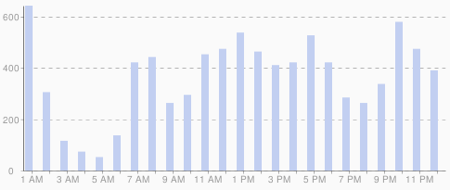The New York Times has unveiled a new feature, Times Wire, which streams every last bit of content produced by the newspaper as it hits the website, from a 6,000-word investigation to the bridge column. It’s a fascinating, if not exactly useful, way to read the news and a testament to the copious material that emerges from the Times every hour — some hours more than others.
Using an RSS feed similar to Times Wire that was quietly released last year, I can graph the newspaper’s hourly publishing schedule on Google Reader. (Josh explained how to do this last year.) As you can see below, the Times is most active at midnight, when the dregs of tomorrow’s paper are finally posted online, but there are also spikes in the 7 a.m., noon, 4 p.m., and 9 p.m. hours. This is a topic I’d like to return to, but for now, what do you see in this chart?
